Digital Trends in the Italian Beer Market: A Time-Series and Search Engine Optimisation Analysis of Gluten-Free and Low/No-Alcohol Beers
Abstract
1. Introduction
- In relation to observed market changes concerning GFB and NABLAB, can the evolution of beer consumption be confirmed through the online search activity of consumers?
- What new patterns of consumer interest and intent are emerging in the Italian beer market, and what future directions are likely to shape demand?
- How can the integration of time-series analysis and descriptive SEO analysis offer a more robust framework for understanding consumer behaviour in niche food and beverage markets?
2. Data and Methods
2.1. Google Trends Tool
2.2. Time Series Analysis
2.3. SEOzoom Tool
3. Results
3.1. Time Series Analysis for Gluten-Free Beers
3.2. SEOzoom Analysis for Gluten-Free Beer
3.3. Time Series Analysis for Non-Alcoholic Beers and Low-Alcoholic Beers
3.4. SEOzoom Analysis for NABLAB
4. Discussion
5. Conclusions
Supplementary Materials
Author Contributions
Funding
Data Availability Statement
Acknowledgments
Conflicts of Interest
Abbreviations
| SEO | Search Engine Optimisation |
| SERPs | Search Engine Results Pages |
| GFB | Gluten Free Beers |
| GT | Google Trends |
| NABLAB | No-Alcohol Beer, Low-Alcohol Beer |
| ZA | Zoom Authority |
Appendix A
| PREPOSITION | |||
|---|---|---|---|
| Preposition | Query (IT-EN) | Volume | |
| senza (without) | birra senza glutine | gluten-free beer | 3600 |
| lievito di birra senza glutine | gluten-free brewer’s yeast | 260 | |
| birra artigianale senza glutine | gluten-free craft beer | 170 | |
| birra peroni senza glutine | gluten-free peroni beer | 140 | |
| birra senza glutine ingredienti | gluten-free beer ingredients | 140 | |
| birra senza glutine supermercati | gluten-free beer supermarkets | 140 | |
| di (of) | lievito di birra senza glutine | gluten-free brewer’s yeast | 260 |
| pizza senza glutine con lievito di birra | gluten-free pizza with brewer’s yeast | 90 | |
| lievito di birra fresco senza glutine | fresh gluten-free brewer’s yeast | 40 | |
| lievito di birra è senza glutine | brewer’s yeast is gluten-free | 40 | |
| lievito di birra marche | brewer’s yeast brands | 90 | |
| lievito di birra fresco supermercati | fresh brewer’s yeast supermarkets | 50 | |
| con (with) | birra senza glutine con malto d’orzo | gluten-free beer with barley malt | 10 |
| pastella con birra senza glutine | gluten-free beer batter | 10 | |
| pub con birra senza glutine roma | pubs with gluten-free beer Rome | 10 | |
| colomba senza glutine con lievito di birra | gluten-free colomba with brewer’s yeast | 10 | |
| pandoro senza glutine con lievito di birra | gluten-free pandoro with brewer’s yeast | 20 | |
| pizza senza glutine con lievito di birra | gluten-free pizza with brewer’s yeast | 30 | |
| per (for) | malto senza glutine per birra | gluten-free malt for beer | 10 |
| malto per birra senza glutine | malt for gluten-free beer | 10 | |
| kit per birra senza glutine | kit for gluten-free beer | 10 | |
| ricetta per birra senza glutine | recipe for gluten-free beer | 10 | |
| ingredienti per birra senza glutine | ingredients for gluten-free beer | 10 | |
| birra senza glutine fatta in casa | homemade gluten-free beer | 10 | |
| In | birra senza glutine in lattina | canned gluten-free beer | 10 |
| birra senza glutine eurospin prezzo | gluten-free beer eurospin price | 10 | |
| birra baladin nazionale senza glutine | national gluten-free Baladin beer | 10 | |
| birra baladin senza glutine | gluten-free Baladin beer | 10 | |
| fare la birra senza glutine in casa | making gluten-free beer at home | 10 | |
| QUESTIONS | |||
| Question Type | Query (IT-EN) | Volume | |
| quale (which) | quale birra senza glutine | which gluten-free beer | 10 |
| qual è la birra senza glutine | what is gluten-free beer | <10 | |
| birra senza glutine quali | which gluten-free beer | <10 | |
| come (how) | come fare birra senza glutine | how to make gluten-free beer | <10 |
| come produrre birra senza glutine | how to produce gluten-free beer | <10 | |
| birra senza glutine come si fa | how to make gluten-free beer | <10 | |
| come fanno la birra senza glutine | how they make gluten-free beer | <10 | |
| come fare la birra senza glutine | how to make gluten-free beer | <10 | |
| birra senza glutine come | gluten-free beer how | <10 | |
| cosa (what) | birra senza glutine cosa contiene | gluten-free beer what it contains | <10 |
| birra senza glutine cosa cambia | gluten-free beer what changes | <10 | |
| cosa contiene la birra senza glutine | what gluten-free beer contains | <10 | |
| dove (where | dove trovare birra peroni senza glutine | where to find gluten-free Peroni beer | 10 |
| dove trovare birra senza glutine | where to find gluten-free beer | <10 | |
| birra peroni senza glutine dove trovarla | gluten-free Peroni beer where to find it | <10 | |
| dove comprare birra senza glutine | where to buy gluten-free beer | <10 | |
| dove acquistare birra senza glutine | where to purchase gluten-free beer | <10 | |
| birra senza glutine dove comprare | gluten-free beer where to buy | <10 | |
| ACTIONS | |||
| Action | Query (IT-EN) | Volume | |
| produrre (produce) | come produrre birra senza glutine | how to produce gluten-free beer | <10 |
| produrre birra artigianale senza glutine | produce gluten-free craft beer | <10 | |
| produrre birra senza glutine | produce gluten-free beer | 10 | |
| comprare (buy) | birra senza glutine dove comprare | gluten-free beer where to buy | <10 |
| dove comprare birra senza glutine | where to buy gluten-free beer | 10 | |
| PREPOSITION | |||
|---|---|---|---|
| Preposition | Query (IT-EN) | Volume | |
| per (for) | malti per birra analcolica | malt for non-alcoholic beer | 10 |
| birra analcolica per bambini | non-alcoholic beer for children | <10 | |
| birra analcolica per celiaci | non-alcoholic beer for coeliacs | <10 | |
| birra analcolica per capelli | non-alcoholic beer for hair | <10 | |
| birra analcolica per capelli ricci | non-alcoholic beer for curly hair | <10 | |
| birra analcolica per diabetici | non-alcoholic beer for diabetics | <10 | |
| di (of)10 | marche di birra analcolica | brands of non-alcoholic beer | 10 |
| birra di riso analcolica vendita | non-alcoholic rice beer for sale | <10 | |
| calorie di una birra analcolica | calories in a non-alcoholic beer | <10 | |
| tipi di birra analcolica | types of non-alcoholic beer | <10 | |
| quanti gradi ha la birra analcolica | how many degrees is non-alcoholic beer | <10 | |
| produzione di birra analcolica | production of non-alcoholic beer | <10 | |
| In | birra analcolica in gravidanza | non-alcoholic beer during pregnancy | 880 |
| birra analcolica in allattamento | non-alcoholic beer when breastfeeding | 70 | |
| birra analcolica in gravidanza forum | non-alcoholic beer during pregnancy forum | 50 | |
| come fare la birra analcolica in casa | how to make non-alcoholic beer at home | 10 | |
| birra analcolica in tour in gravidanza | non-alcoholic beer on tour when pregnant | 10 | |
| posso bere la birra analcolica in gravidanza | can I drink non-alcoholic beer when pregnant | 10 | |
| come (how) | come viene fatta la birra analcolica | how is non-alcoholic beer made | 90 |
| come fare la birra analcolica | how to make non-alcoholic beer | 10 | |
| come fare birra analcolica | how to make non-alcoholic beer | 10 | |
| falsi come una birra analcolica | fake as a non-alcoholic beer | 10 | |
| birra analcolica come si fa | non-alcoholic beer how it is made | 10 | |
| come si fa birra analcolica | how to make non-alcoholic beer | 10 | |
| senza (without) | birra analcolica e senza glutine | non-alcoholic and gluten-free beer | 110 |
| birra senza glutine analcolica | non-alcoholic gluten-free beer | <10 | |
| birra analcolica senza zucchero | non-alcoholic beer without sugar | <10 | |
| birra analcolica senza alcol | non-alcoholic beer without alcohol | <10 | |
| birra analcolica senza glutine | non-alcoholic beer gluten-free | <10 | |
| senza senso come la birra analcolica | nonsense like non-alcoholic beer | <10 | |
| QUESTIONS | |||
| Question Type | Query (IT-EN) | Volume | |
| quale (which) | qual è la migliore birra analcolica | which is the best non-alcoholic beer | <10 |
| quale è la miglior birra analcolica | which is the best non-alcoholic beer | <10 | |
| come (how) | come si fa la birra analcolica | how do you make non-alcoholic beer | 90 |
| birra analcolica come si fa | non-alcoholic beer how does you make it | 10 | |
| falsi come una birra analcolica | as cool as a non-alcoholic beer | 10 | |
| come fare la birra analcolica | how to make non-alcoholic beer | 10 | |
| come fare la birra analcolica in casa | how to make non-alcoholic beer at home | 10 | |
| cosa (what) | birra analcolica cosa è | non-alcoholic beer what is it | <10 |
| birra analcolica cosa fare | non-alcoholic beer what to do | <10 | |
| cosa fare con birra analcolica | what to do with non-alcoholic beer | <10 | |
| birra analcolica cosa contiene | non-alcoholic beer what it contains | <10 | |
| cosa contiene la birra analcolica | what non-alcoholic beer contains | <10 | |
| dove (where | birra analcolica dove si compra | non-alcoholic beer where to buy it | <10 |
| birra analcolica forse dove comprarla | non-alcoholic beer maybe where to buy it | <10 | |
| dove acquistare birra analcolica | where to buy non-alcoholic beer | <10 | |
| birra analcolica dove comprarla | non-alcoholic beer where to buy it | <10 | |
| dove comprare birra analcolica | where to buy non-alcoholic beer | <10 | |
| ACTIONS | |||
| Action | Query (IT-EN) | Volume | |
| fare (do) | come fanno a fare la birra analcolica | how do they make non-alcoholic beer | <10 |
| come fare birra analcolica in casa | how to make non-alcoholic beer at home | <10 | |
| fare la birra analcolica | make non-alcoholic beer | <10 | |
| come fare birra analcolica | how to make non-alcoholic beer | <10 | |
| come fare la birra analcolica | how to make non-alcoholic beer | 10 | |
| come fare la birra analcolica in casa | how to make non-alcoholic beer at home | 10 | |
| bere (drink) | quanta birra analcolica bere | how much non-alcoholic beer to drink | <10 |
| bere birra analcolica in gravidanza | drink non-alcoholic beer when pregnant | 20 | |
| posso bere la birra analcolica | can I drink non-alcoholic beer | <10 | |
| si può bere la birra analcolica | can you drink non-alcoholic beer | 10 | |
| posso bere la birra analcolica in gravidanza | can I drink non-alcoholic beer when pregnant | 10 | |
| si può bere birra analcolica in gravidanza | can you drink non-alcoholic beer when pregnant | 20 | |
| bere birra analcolica fa male | is drinking non-alcoholic beer bad for you | 10 | |
| vendere (sell) | birra analcolica si può vendere ai minorenni | can non-alcoholic beer be sold to minors | 10 |
| gonfiare (grow) | la birra analcolica fa gonfiare la pancia | non-alcoholic beer makes your belly grow | 10 |
| la birra analcolica fa gonfiare | non-alcoholic beer makes you gain weight | <10 | |
| ingrassare (fatten) | birra analcolica fa ingrassare | does non-alcoholic beer make you put on weight | 110 |
| la birra analcolica fa ingrassare | does non-alcoholic beer make you put on weight | 30 | |
| fa ingrassare la birra analcolica | does non-alcoholic beer make you put on weight | 10 | |
| birra analcolica non ingrassa | non-alcoholic beer does not make you put on weight | 10 | |
| quanto fa ingrassare la birra analcolica | how much does non-alcoholic beer make you put on weight | 10 | |
References
- Essa, M.M.; Bishir, M.; Bhat, A.; Chidambaram, S.B.; Al-Balushi, B.; Hamdan, H.; Govindarajan, N.; Freidland, R.P.; Qoronfleh, M.W. Functional foods and their impact on health. J. Food Sci. Technol. 2023, 60, 820–834. [Google Scholar] [CrossRef]
- Pistorio, E.; Chinnici, G.; Carla, Z.; Bellia, C.; Pappalardo, G. The Revolution of Functional Food: A Market Analysis (The Functional Foods Market Revolution: Market Analysis of Functional Food). Int. Multidiscip. Sci. GeoConf. SGEM 2023, 23, 433–441. [Google Scholar] [CrossRef]
- Baker, M.T.; Lu, P.; Parrella, J.A.; Leggette, H.R. Consumer Acceptance toward Functional Foods: A Scoping Review. Int. J. Environ. Res. Public Health 2022, 19, 1217. [Google Scholar] [CrossRef]
- Topolska, K.; Florkiewicz, A.; Filipiak-Florkiewicz, A. Functional Food—Consumer Motivations and Expectations. Int. J. Environ. Res. Public Health 2021, 18, 5327. [Google Scholar] [CrossRef] [PubMed]
- Salanță, L.C.; Coldea, T.E.; Ignat, M.V.; Pop, C.R.; Tofană, M.; Mudura, E.; Borșa, A.; Pasqualone, A.; Anjos, O.; Zhao, H. Functionality of Special Beer Processes and Potential Health Benefits. Processes 2020, 8, 1613. [Google Scholar] [CrossRef]
- De Pascale, A.; Lanfranchi, M.; Zanchini, R.; Giannetto, C.; D’Amico, M.; Di Vita, G. Craft beer preferences among digitarians in Italy. Int. J. Wine Bus. Res. 2023, 36, 207–229. [Google Scholar] [CrossRef]
- Maior, L.; Sola, I.; Lacerda, L.; Demiate, I.; Alberti, A.; Nogueira, A. Current Facts about Gluten-Free Beverages. In Food Intolerances; CRC Press: Boca Raton, FL, USA, 2024; pp. 98–113. ISBN 978-1-003-40280-0. [Google Scholar] [CrossRef]
- Steinhobel, E.; Roberts-Lombard, M.; Lubbe, I. Understanding Millennial relationships and consumption of no and low alcohol beer brands. S. Afr. J. Bus. Manag. 2024, 55, 1–16. [Google Scholar] [CrossRef]
- AssoBirra. Annual Report 2024. 2025. Available online: https://www.assobirra.it/annual-report-assobirra/ (accessed on 20 July 2025).
- Bernetti, I.; Alampi Sottini, V.; Cipollaro, M.; Menghini, S. A survey on the performance of the Italian brewing companies. Ital. Rev. Agric. Econ. REA 2020, 75, 37–50. [Google Scholar] [CrossRef]
- Fastigi, M.; Cavanaugh, J.R. Turning Passion into Profession: A History of Craft Beer in Italy. Gastronomica 2017, 17, 39–50. [Google Scholar] [CrossRef]
- Garavaglia, C.; Borgoni, R. The local dimension of legitimation: An empirical analysis of firms’ entry in the Italian craft beer market. Reg. Stud. 2023, 57, 1909–1923. [Google Scholar] [CrossRef]
- The Brewers of Europe. European Beer Trends. Statistics Eeport, 2023 Edition. 2024. Available online: https://brewersofeurope.eu/european-beer-trends-2024-edition-and-previous-years/ (accessed on 20 July 2025).
- Barbagallo, R.; Rutigliano, C.; Rizzo, V.; Muratore, G. Innovative trends and strategies for the integral valorization of products in the beer supply chain. Ital. J. Food Sci. 2024, 36, 20–39. [Google Scholar] [CrossRef]
- Barbagallo, R.N.; Rutigliano, C.A.C.; Rizzo, V.; Muratore, G. Exploring beer culture dissemination and quality perception through different media: The craft beer experience. Food Humanit. 2025, 4, 100522. [Google Scholar] [CrossRef]
- Cela, N.; Fontefrancesco, M.F.; Torri, L. Fruitful Brewing: Exploring Consumers’ and Producers’ Attitudes towards Beer Produced with Local Fruit and Agroindustrial By-Products. Foods 2024, 13, 2674. [Google Scholar] [CrossRef]
- García-Chamizo, F.; Ávila Rodríguez-de-Mier, B.; López-Agulló Pérez-Caballero, J.M. Sustainable branding and innovation in the craft beer sector. Br. Food J. 2025, 127, 643–661. [Google Scholar] [CrossRef]
- Cipollaro, M.; Fabbrizzi, S.; Sottini, V.A.; Fabbri, B.; Menghini, S. Linking Sustainability, Embeddedness and Marketing Strategies: A Study on the Craft Beer Sector in Italy. Sustainability 2021, 13, 10903. [Google Scholar] [CrossRef]
- Lima, A.; Teixeira, S.; Cruz, M. The Influence of Social Media Marketing Activity on Purchase Intention in the Beer Sector: Case of SuperBock’s Instagram. In Marketing and Smart Technologies; Reis, J.L., Zelený, J., Gavurová, B., dos Santos, J.P.M., Eds.; Springer Nature Singapore: Singapore, 2024; pp. 327–341. [Google Scholar]
- Morgan, D.R.; Thomas Lane, E.; Styles, D. Crafty Marketing: An Evaluation of Distinctive Criteria for “Craft” Beer. Food Rev. Int. 2022, 38, 913–929. [Google Scholar] [CrossRef]
- Cascone, G.; Tuccio, G.; Timpanaro, G. Analysis of Italian craft beer consumers: Preferences and purchasing behaviour. Br. Food J. 2024, 127, 914–935. [Google Scholar] [CrossRef]
- He, B.; Leng, K.K.K.; Ismail, N.; Lian, L.K.; Chen, Y. Impact of Online Marketing Strategies on Brand Value and Purchase Intention in the Beer Industry: A Study of Internet-Based Promotions and Digital Advertising. In Proceedings of the 2023 International Conference on Computer Science and Emerging Technologies (CSET), Bangalore, India, 10–12 October 2023; pp. 1–6. [Google Scholar] [CrossRef]
- Arana-Torres, R.; Cespedes, C.; Elias-Giordano, C.; Nieves-Asencio, A.; Torres-Sifuentes, C. Management Model to increase sales through Digital Marketing and the 4Ps of marketing in a craft brewery. In Proceedings of the 3rd LACCEI International Multiconference on Entrepreneurship, Innovation and Regional Development (LEIRD 2023): “Igniting the Spark of Innovation: Emerging Trends, Disruptive Technologies, and Innovative Models for Business Success”, Latin American and Caribbean Consortium of Engineering Institutions, San Juan, Puerto Rico, 4–6 December 2023. [Google Scholar] [CrossRef]
- Lakshmi, S.R.; Manasa, N. Role of Digital Marketing Tactics in Enhancing Financial Performance in E-Commerce Enterprises. In Artificial Intelligence in Peace, Justice, and Strong Institutions; Kaunert, C., Raghav, A., Ravesangar, K., Singh, B., Riswandi, B.A., Eds.; IGI Global Scientific Publishing: Hershey, PA, USA, 2025; pp. 257–282. ISBN 979-8-3693-9395-6. [Google Scholar] [CrossRef]
- Correia, E.; Mandel, J.; Cullison, S.R.J. Analyzing Social Media Trends in Cosmeceuticals: Insights From Google Trends and TikTok Analytics. J. Cosmet. Dermatol. 2025, 24, e70172. [Google Scholar] [CrossRef]
- Mavragani, A.; Ochoa, G. Google Trends in Infodemiology and Infoveillance: Methodology Framework. JMIR Public Health Surveill 2019, 5, e13439. [Google Scholar] [CrossRef] [PubMed]
- Tirkeş, G.; Güray, C.; Çelebi, N. Demand forecasting: A comparison between the holt-winters, trend analysis and decomposition models. Teh. Vjesn. 2017, 24, 503–509. [Google Scholar] [CrossRef]
- Kreuzer, T.; Zdravkovic, J.; Papapetrou, P. Unpacking the trend: Decomposition as a catalyst to enhance time series forecasting models. Data Min. Knowl. Discov. 2025, 39, 54. [Google Scholar] [CrossRef]
- Al-Haraizah, A.; Abdelfattah, F.A.; Rehman, S.U.; Ismaeel, B.; Mufleh, M.; Omeish, F.Y. The impact of search engine optimization and website engagement towards customer buying behaviour. Glob. Knowl. Mem. Commun. 2025; ahead-of-print. [Google Scholar] [CrossRef]
- Srinivas, V.M.; Halli Cheluvae Gowda, P.M. A page rank-based analytical design of effective search engine optimization. Iaes Int. J. Artif. Intell. (Ij-Ai) 2025, 14, 73. [Google Scholar] [CrossRef]
- Gregurec, I.; Grd, P. Search Engine Optimization (SEO): Website analysis of selected faculties in Croatia. In Proceedings of the Central European Conference on Information and Intelligent Systems, Varaždin, Croatia, 19–21 September 2012. [Google Scholar]
- Patil, V.M.; Patil, A.V. SEO: On-Page + Off-Page Analysis. In Proceedings of the 2018 International Conference on Information, Communication, Engineering and Technology (ICICET), Pune, India, 29–31 August 2018; pp. 1–3. [Google Scholar] [CrossRef]
- Vállez, M.; Ventura, A. Analysis of the SEO visibility of university libraries and how they impact the web visibility of their universities. J. Acad. Librariansh. 2020, 46, 102171. [Google Scholar] [CrossRef]
- Choi, H.; Varian, H. Predicting the Present with Google Trends. Econ. Rec. 2012, 88, 2–9. [Google Scholar] [CrossRef]
- Cebrián, E.; Domenech, J. Addressing Google Trends inconsistencies. Technol. Forecast. Soc. Change 2024, 202, 123318. [Google Scholar] [CrossRef]
- Mavragani, A.; Ochoa, G.; Tsagarakis, K.P. Assessing the Methods, Tools, and Statistical Approaches in Google Trends Research: Systematic Review. J. Med. Internet Res. 2018, 20, e270. [Google Scholar] [CrossRef]
- Fang, Q.; Burger, J.; Meijers, R.; Van Berkel, K. The Role of Time, Weather and Google Trends in Understanding and Predicting Web Survey Response. Surv. Res. Methods 2021, 15, 1–25. [Google Scholar] [CrossRef]
- Cebrián, E.; Domenech, J. Is Google Trends a quality data source? Appl. Econ. Lett. 2023, 30, 811–815. [Google Scholar] [CrossRef]
- Hölzl, J.; Keusch, F.; Sajons, C. The (mis)use of Google Trends data in the social sciences-A systematic review, critique, and recommendations. Soc. Sci. Res. 2025, 126, 103099. [Google Scholar] [CrossRef]
- Jun, S.-P.; Yoo, H.S.; Choi, S. Ten years of research change using Google Trends: From the perspective of big data utilizations and applications. Technol. Forecast. Soc. Change 2018, 130, 69–87. [Google Scholar] [CrossRef]
- Nuti, S.V.; Wayda, B.; Ranasinghe, I.; Wang, S.; Dreyer, R.P.; Chen, S.I.; Murugiah, K. The Use of Google Trends in Health Care Research: A Systematic Review. PLoS ONE 2014, 9, e109583. [Google Scholar] [CrossRef]
- Arora, V.S.; McKee, M.; Stuckler, D. Google Trends: Opportunities and limitations in health and health policy research. Health Policy 2019, 123, 338–341. [Google Scholar] [CrossRef]
- Chu, A.M.Y.; Tsang, J.T.Y.; Chan, S.S.C.; Chan, L.S.H.; So, M.K.P. Utilizing Google Trends data to enhance forecasts and monitor long COVID prevalence. Commun. Med. 2025, 5, 179. [Google Scholar] [CrossRef] [PubMed]
- Hrytsenko, L.; Krawczyk, D.; Derkach, L.; Kolomiiets, S. The Role of Smart City in Achieving Sustainable Development: Google Trends Analysis and Exponential Time Series Smoothing Models. Bus. Ethics Leadersh. 2024, 8, 190–202. [Google Scholar] [CrossRef]
- Bangwayo-Skeete, P.F.; Skeete, R.W. Can Google data improve the forecasting performance of tourist arrivals? Mixed-data sampling approach. Tour. Manag. 2015, 46, 454–464. [Google Scholar] [CrossRef]
- Ohana-Levi, N.; Munitz, S.; Ben-Gal, A.; Netzer, Y. Evaluation of within-season grapevine evapotranspiration patterns and drivers using generalized additive models. Agric. Water Manag. 2020, 228, 105808. [Google Scholar] [CrossRef]
- Tanaka, H.; Maezawa, M.; Hirofuji, S.; Miyasaka, K.; Nakao, S.; Nokura, Y.; Yamashita, M.; Ichihara, N.; Sugishita, K.; Yamazaki, T.; et al. Seasonal Variations in Drug-Related Erythema Multiforme: A Time Series Analysis Using the JADER Database. Biol. Pharm. Bull. 2025, 48, 1022–1030. [Google Scholar] [CrossRef]
- Shumway, R.H.; Stoffer, D.S. Time Series Analysis and Its Applications: With R Examples. In Springer Texts in Statistics; Springer Nature: Cham, Switzerland, 2025; ISBN 978-3-031-70583-0. [Google Scholar] [CrossRef]
- Gomes, H.; Parasram, V.; Collins, J.; Socias-Morales, C. Time series, seasonality and trend evaluation of 7 years (2015–2021) of OSHA severe injury data. J. Safety Res. 2023, 86, 30–38. [Google Scholar] [CrossRef]
- Chen, H.; Xiao, M. Seasonality of influenza-like illness and short-term forecasting model in Chongqing from 2010 to 2022. BMC Infect. Dis. 2024, 24, 432. [Google Scholar] [CrossRef] [PubMed]
- Petropoulos, F.; Apiletti, D.; Assimakopoulos, V.; Babai, M.Z.; Barrow, D.K.; Ben Taieb, S.; Bergmeir, C.; Bessa, R.J.; Bijak, J.; Boylan, J.E.; et al. Forecasting: Theory and practice. Int. J. Forecast. 2022, 38, 705–871. [Google Scholar] [CrossRef]
- Maley, C.; Baum, N. Getting to the top of Google: Search engine optimization. J. Med. Pract. Manag. MPM 2010, 25, 301–303. [Google Scholar]
- Baye, M.R.; De los Santos, B.; Wildenbeest, M.R. Search Engine Optimization: What Drives Organic Traffic to Retail Sites? J. Econ. Manag. Strategy 2016, 25, 6–31. [Google Scholar] [CrossRef]
- Duka, M.; Sikora, M.; Strzelecki, A. From Web Catalogs to Google: A Retrospective Study of Web Search Engines Sustainable Development. Sustainability 2023, 15, 6768. [Google Scholar] [CrossRef]
- Sheffield, J.P. Search Engine Optimization and Business Communication Instruction: Interviews With Experts. Bus. Prof. Commun. Q. 2020, 83, 153–183. [Google Scholar] [CrossRef]
- Nagpal, M.; Petersen, J.A. Keyword Selection Strategies in Search Engine Optimization: How Relevant is Relevance? J. Retail. 2021, 97, 746–763. [Google Scholar] [CrossRef]
- Hidayah, N.; Gaffar, V.; Arief, M. Search marketing: Systematic literature review. Int. J. Internet Mark. Advert. 2025, 22, 162–186. [Google Scholar] [CrossRef]
- Carrière-Swallow, Y.; Labbé, F. Nowcasting with Google Trends in an Emerging Market. J. Forecast. 2013, 32, 289–298. [Google Scholar] [CrossRef]
- Aiello, M. Functional Foods: Between New Consumption Trends and Renewed Perceptions of Health. Ital. Sociol. Rev. 2011, 1, 45. [Google Scholar] [CrossRef]
- Alibudbud, R. Google Trends for health research: Its advantages, application, methodological considerations, and limitations in psychiatric and mental health infodemiology. Front. Big Data 2023, 6, 1132764. [Google Scholar] [CrossRef]
- Figueiredo, N.; Ferreira, B.M.; Abrantes, J.L.; Martinez, L.F. The Role of Digital Marketing in Online Shopping: A Bibliometric Analysis for Decoding Consumer Behavior. J. Theor. Appl. Electron. Commer. Res. 2025, 20, 25. [Google Scholar] [CrossRef]
- Hokmabadi, H.; Rezvani, S.M.H.S.; de Matos, C.A. Business Resilience for Small and Medium Enterprises and Startups by Digital Transformation and the Role of Marketing Capabilities—A Systematic Review. Systems 2024, 12, 220. [Google Scholar] [CrossRef]
- Ponzoa, J.M.; Gómez, A.; Arilla, R. Business interest associations in the USA and Europe: Evaluation of digital marketing techniques applied on their websites and social networks. J. Enterprising Communities People Places Glob. Econ. 2023, 19, 66–91. [Google Scholar] [CrossRef]
- Vettriselvan, R. Harnessing innovation and digital marketing in the era of industry 5.0: Resilient healthcare SMEs. In The Future of Small Business in Industry 5.0; IGI Global Scientific Publishing: Hershey, PA, USA, 2024; pp. 163–186. [Google Scholar] [CrossRef]


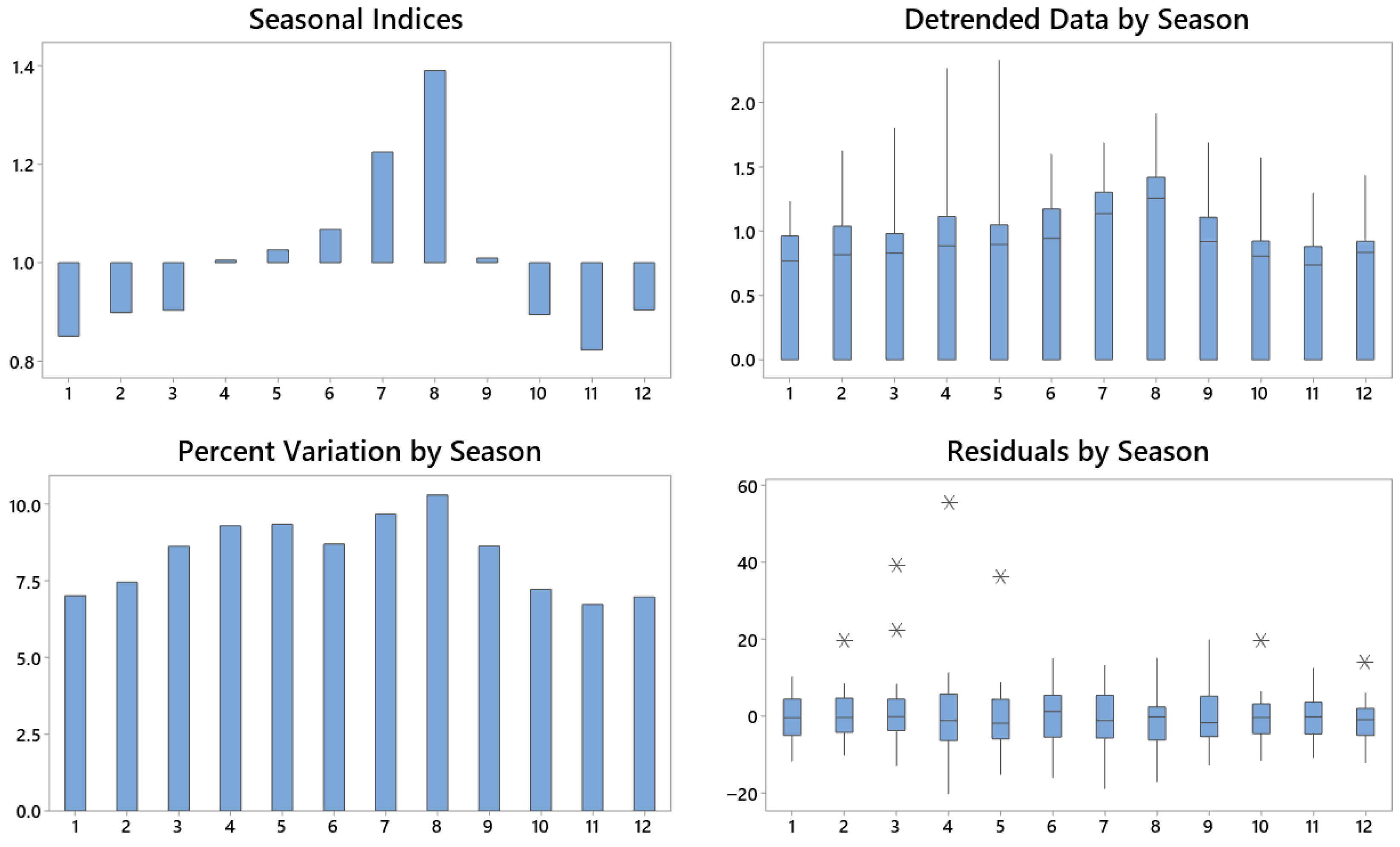
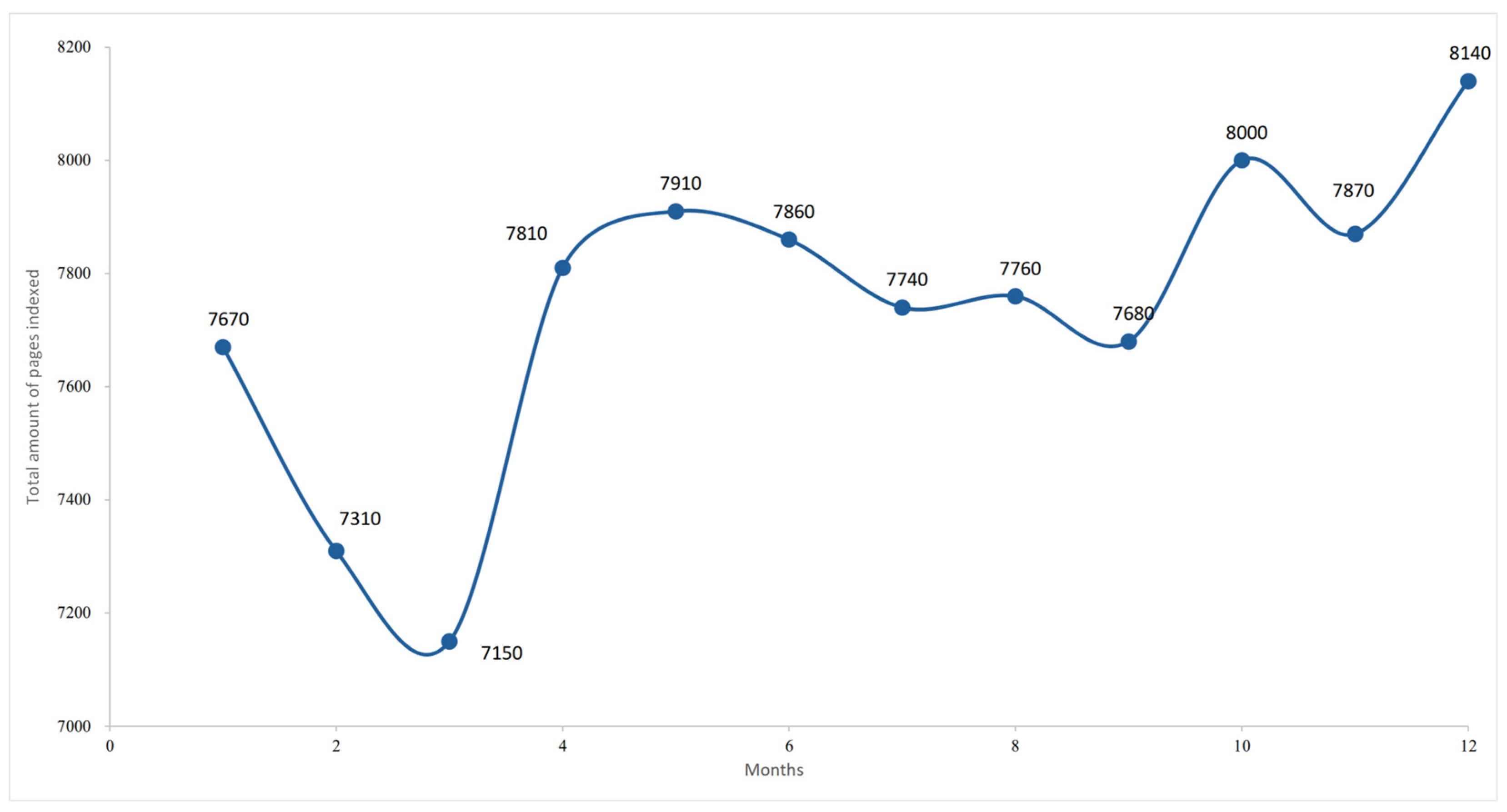
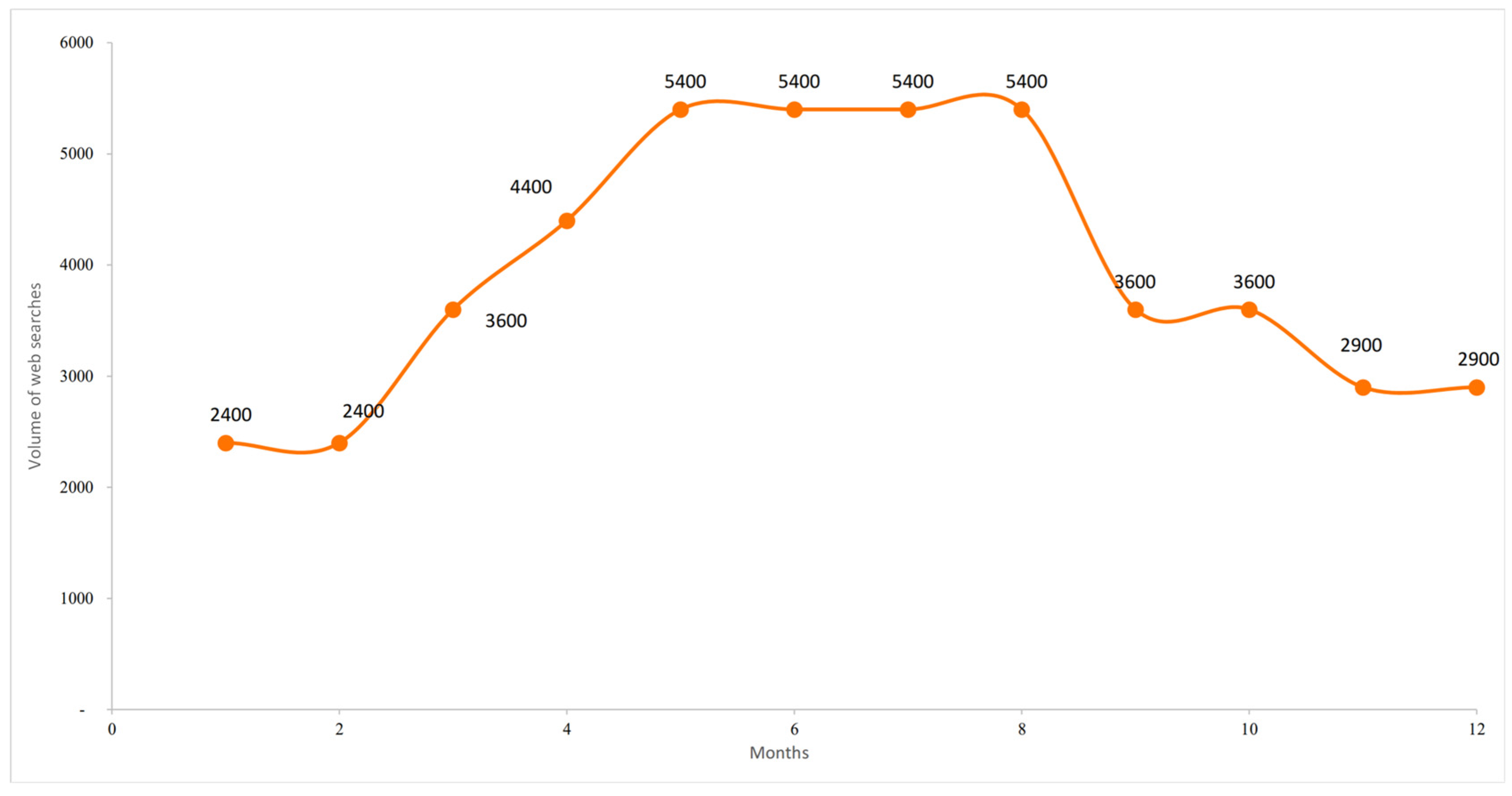
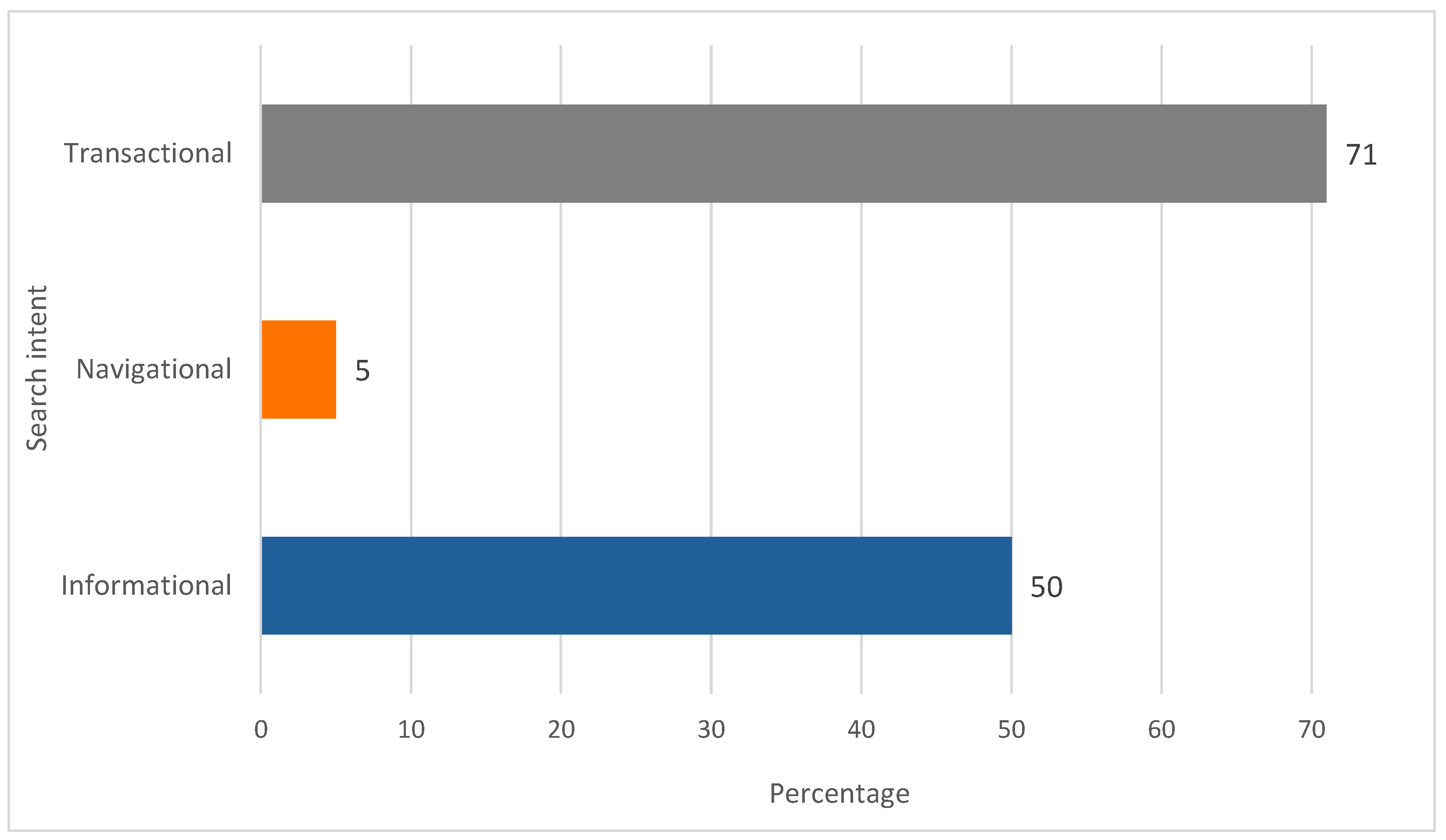



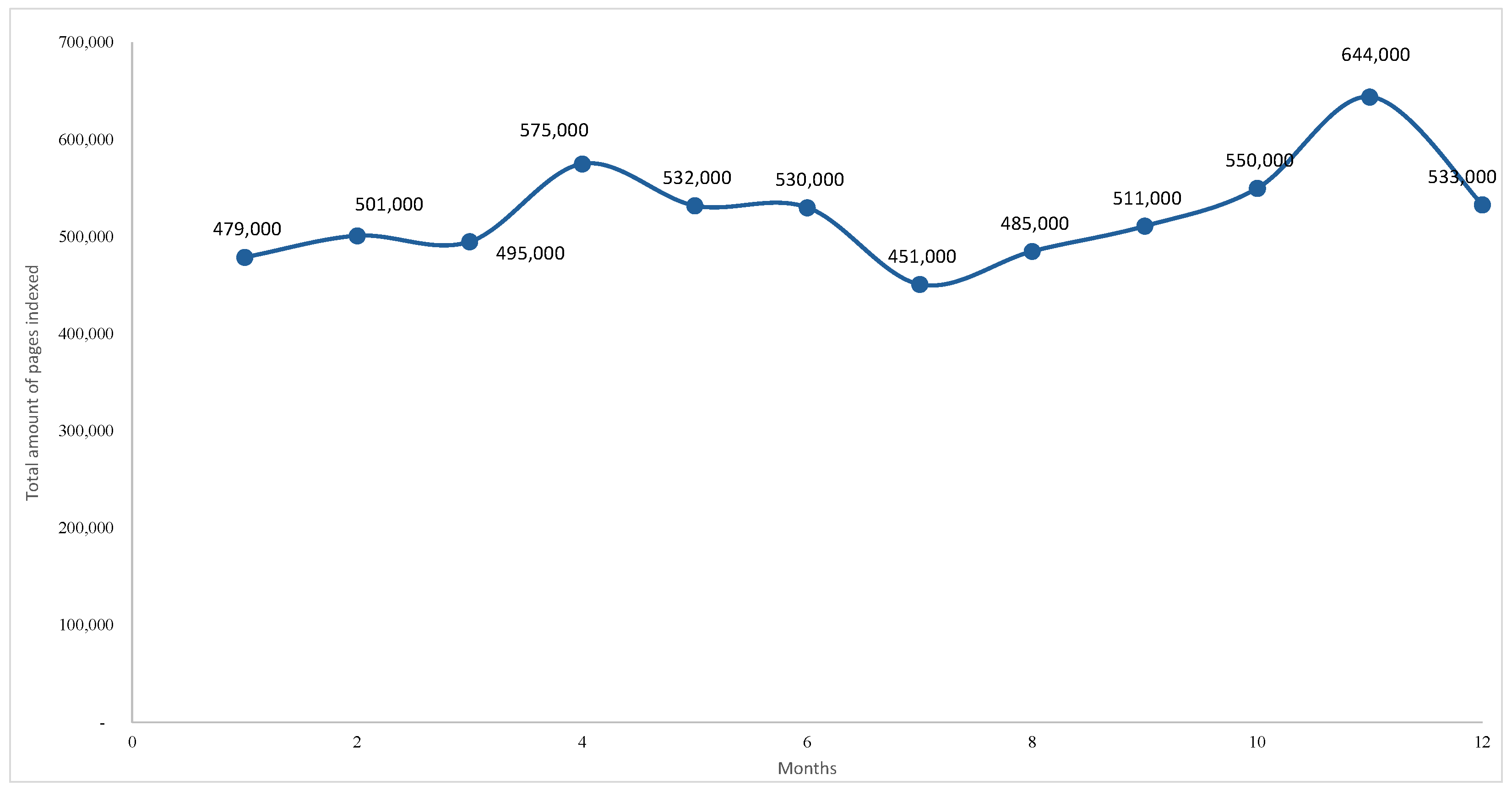
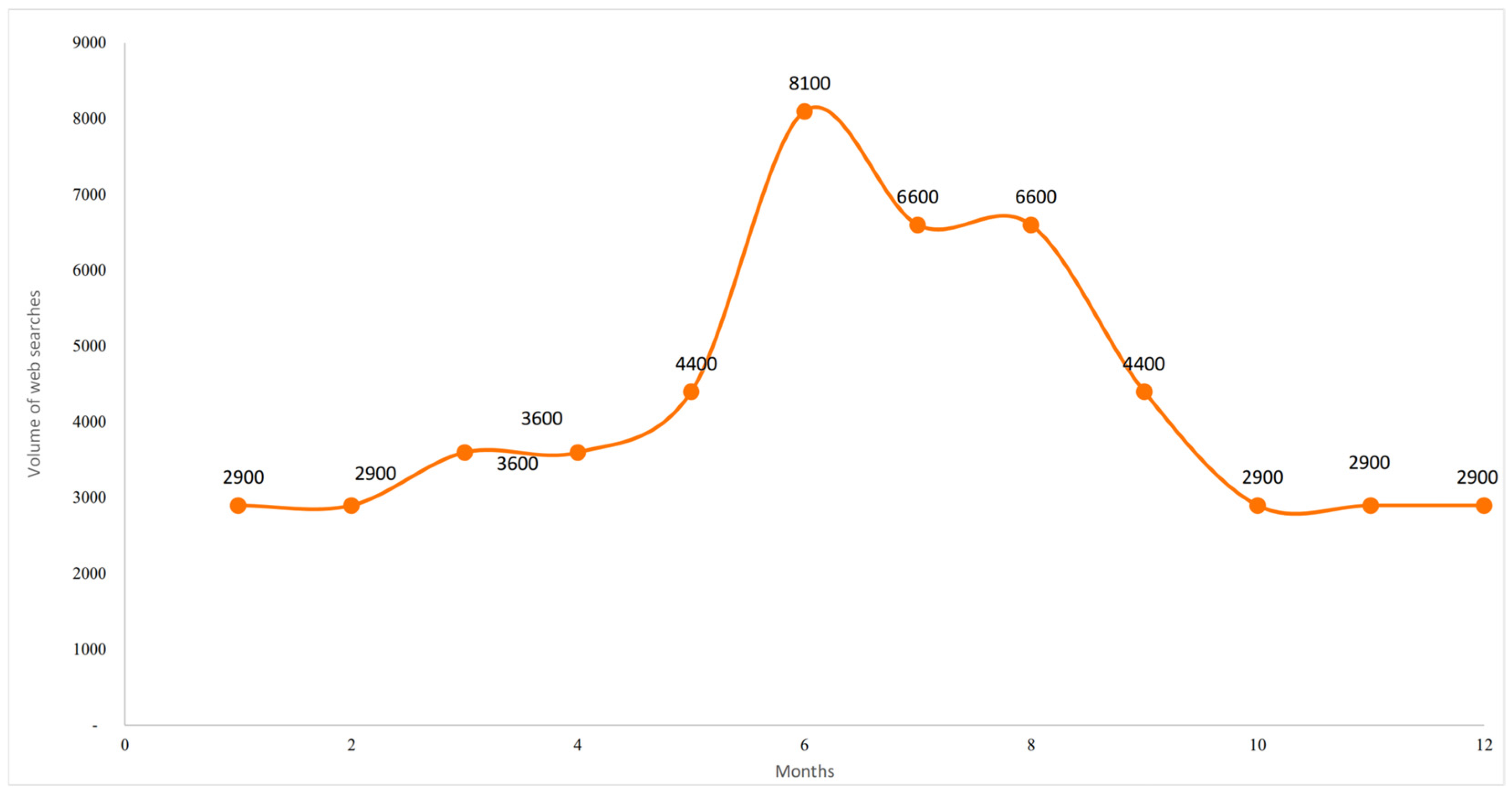

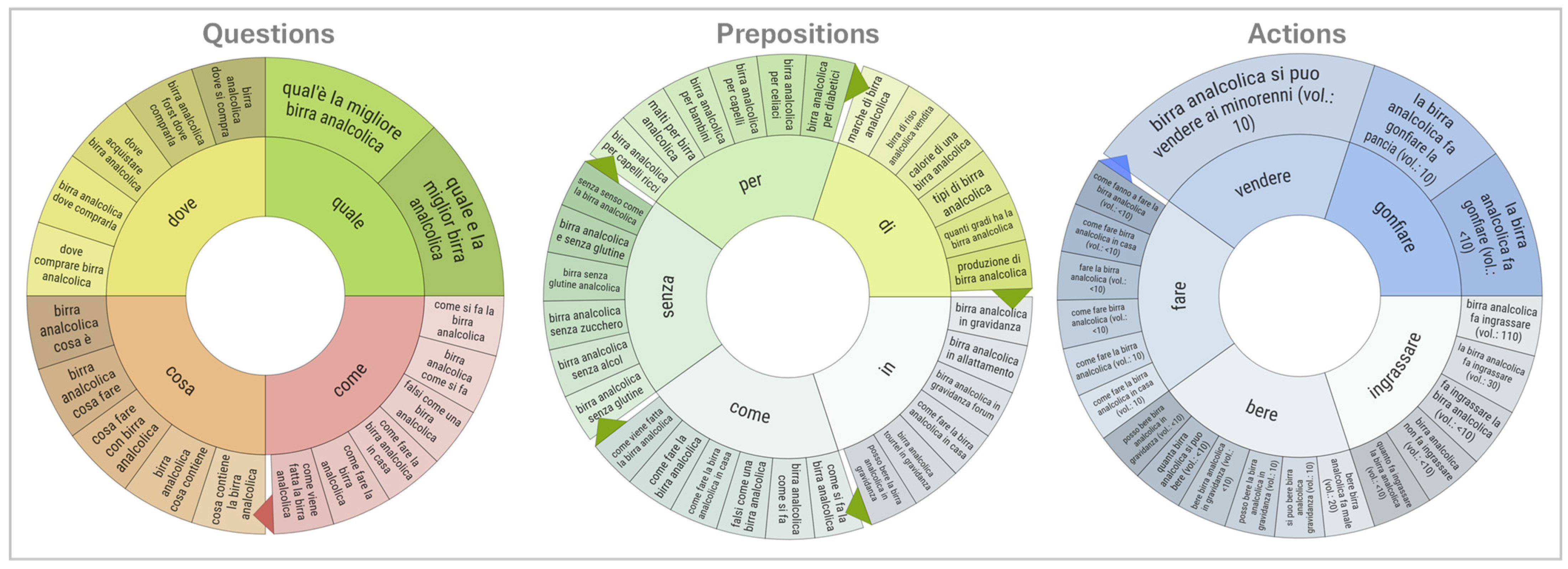
| SEOZoom Indicators | Description |
|---|---|
| Variation in indexed pages | This metric quantifies the monthly change in the number of web pages indexed by search engines that contain the selected keywords. It provides an estimate of online content production and competitive density, offering insight into the dynamism of the digital information supply. |
| Variation in search volumes | SEOZoom provides an estimate of the monthly frequency with which a keyword is searched on Google. This parameter, analogous to GT yet expressed in absolute values, measures user demand and its temporal fluctuations, thereby reflecting interest dynamics and seasonality. |
| Search intent classification | Each keyword is associated with a dominant search intent (e.g., informational, navigational, transactional, or mixed). This classification helps to identify whether users are seeking knowledge, specific brands, or purchase opportunities, thus providing insight into the consumer’s decision-making stage. |
| Traffic share per domain | This indicator estimates the percentage of total organic traffic captured by a specific website from a given keyword cluster. It reveals the competitive positioning of different domains and the concentration of user attention within that online ecosystem. |
| Zoom Authority (ZA) | A proprietary SEOZoom metric, the ZA score quantifies a website’s authority and competitiveness. It is derived from multiple factors, including organic traffic, backlink profile, and keyword performance. Higher ZA values indicate stronger online visibility and perceived reliability. The indicator is expressed as a scaled value from 0 to 100, where higher scores reflect greater credibility and SEO authority as assessed by the platform. |
| Semantic maps | SEOZoom’s semantic analysis tool identifies the network of related keywords and topics surrounding a main query. This feature facilitates the exploration of semantic proximity, the identification of thematic clusters, and the detection of emerging trends in user search behaviour. |
| URL | Traffic Share (%) | ZA * Scores | |
|---|---|---|---|
| 1 | www.zeroalcol.com | 40.64 | 41 |
| 2 | www.drinkshoponline.com | 15.56 | 54 |
| 3 | www.myalcolzero.it | 9.24 | 37 |
| 4 | www.shop.baladin.it | 5.84 | 41 |
| 5 | www.amazon.it | 5.58 | 94 |
| 6 | www.birramoretti.com | 4.18 | 34 |
| 7 | www.birredamanicomio.com | 3.96 | 52 |
| 8 | www.birrificiodelducato.it | 2.37 | 41 |
| 9 | www.qualitybeeracademy.it | 2.02 | 41 |
| 10 | www.carrefour.it | 1.96 | 67 |
Disclaimer/Publisher’s Note: The statements, opinions and data contained in all publications are solely those of the individual author(s) and contributor(s) and not of MDPI and/or the editor(s). MDPI and/or the editor(s) disclaim responsibility for any injury to people or property resulting from any ideas, methods, instructions or products referred to in the content. |
© 2025 by the authors. Licensee MDPI, Basel, Switzerland. This article is an open access article distributed under the terms and conditions of the Creative Commons Attribution (CC BY) license (https://creativecommons.org/licenses/by/4.0/).
Share and Cite
Chinnici, P.; Carbone, K.; Licciardo, F. Digital Trends in the Italian Beer Market: A Time-Series and Search Engine Optimisation Analysis of Gluten-Free and Low/No-Alcohol Beers. Foods 2025, 14, 3789. https://doi.org/10.3390/foods14213789
Chinnici P, Carbone K, Licciardo F. Digital Trends in the Italian Beer Market: A Time-Series and Search Engine Optimisation Analysis of Gluten-Free and Low/No-Alcohol Beers. Foods. 2025; 14(21):3789. https://doi.org/10.3390/foods14213789
Chicago/Turabian StyleChinnici, Pietro, Katya Carbone, and Francesco Licciardo. 2025. "Digital Trends in the Italian Beer Market: A Time-Series and Search Engine Optimisation Analysis of Gluten-Free and Low/No-Alcohol Beers" Foods 14, no. 21: 3789. https://doi.org/10.3390/foods14213789
APA StyleChinnici, P., Carbone, K., & Licciardo, F. (2025). Digital Trends in the Italian Beer Market: A Time-Series and Search Engine Optimisation Analysis of Gluten-Free and Low/No-Alcohol Beers. Foods, 14(21), 3789. https://doi.org/10.3390/foods14213789







